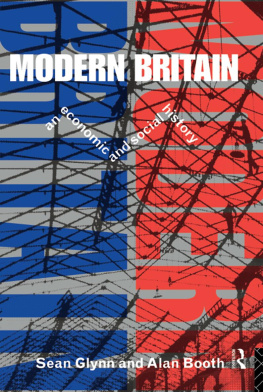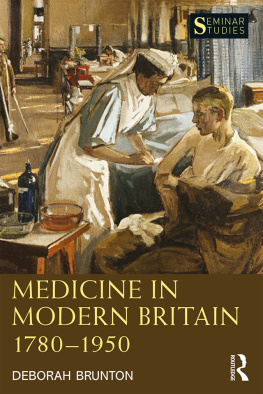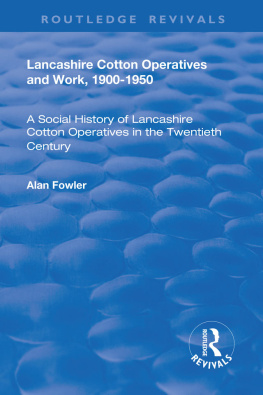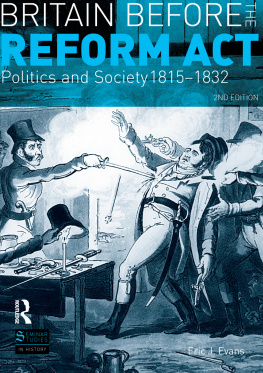Routledge Revivals
Britain 17401950
Originally published in 1992, this book provides students with a well-illustrated, clearly written text which offers a coherent overview of Britains development from a pre-modern to a modern economy and society. The key processes that have shaped the geography of modern Britain are rooted in the significant demographic, economic, technological and social transitions of the early eighteenth century, the impact of which was not fully diffused through the nation until the m id-20th Century. This country-wide survey examines the nature of this transformation. The material in the book is accessible because the book is clearly structured into 3 phases: 1740 to the 1830s; the 1830s to the 1890s and the 1890s to 1950. For each period, the principal aspects of change in population, industry, the countryside and urban life are examined, and regional examples given to support the analysis.
First published in 1992
by Edward Arnold
This edition first published in 2021 by Routledge
2 Park Square, Milton Park, Abingdon, Oxon, OX14 4RN
and by Routledge
605 Third Avenue, New York, NY 10017
Routledge is an imprint of the Taylor & Francis Group, an informa business
1992 Richard Lawton and Colin G. Pooley
All rights reserved. No part of this book may be reprinted or reproduced or utilised in any form or by any electronic, mechanical, or other means, now known or hereafter invented, including photocopying and recording, or in any information storage or retrieval system, without permission in writing from the publishers.
Publishers Note
The publisher has gone to great lengths to ensure the quality of this reprint but points out that some imperfections in the original copies may be apparent.
Disclaimer
The publisher has made every effort to trace copyright holders and welcomes correspondence from those they have been unable to contact.
ISBN 13: 978-1-032-00582-9 (hbk)
ISBN 13: 978-1-003-17478-3 (ebk)
ISBN 13: 978-1-032-00584-3 (pbk)
DOI: 10.4324/9781003174783
BRITAIN 17401950
An Historical Geography
Richard Lawton
and
Colin G. Pooley

1992 Richard Lawton and Colin G. Pooley
First published in Great Britain 1992
Distributed in the USA by Routledge, Chapman and Hall, Inc.
29 West 35th Street, New York, NY 10001
British Library Cataloguing in Publication Data
Lawton, Richard
Britain 17401950: An historical geography.
I. Title II. Pooley, Colin G.
ISBN 0-7131-6550-2
All rights reserved. No part of this publication may be reproduced or transmitted in any form or by any means, electronically or mechanically, including photocopying, recording or any information storage or retrieval system, without either prior permission in writing from the publisher or a licence permitting restricted copying. In the United Kingdom such licences are issued by the Copyright Licensing Agency: 90 Tottenham Court Road, London W1P 9HE.
Typeset in 10/11pt Palatino by Rowland Phototypesetting Limited, Bury St Edmunds, Suffolk. Printed and bound in Great Britain for Edward Arnold, a division of Hodder and Stoughton Limited, Mill Road, Dunton Green, Sevenoaks, Kent TN13 2YA by Biddles Limited, Guildford and Kings Lynn
Contents
3 Demographic change from the 1740s to the 1830s
4 The countryside from the 1740s to the 1830s
5 Industry and industrialization from the 1740s to the 1830s
6 Urbanization and urban life from the 1740s to the 1830s
8 Demographic change from the 1830s to the 1890s
9 The countryside from the 1830s to the 1890s
10 Industry and industrialization from the 1830s to the 1890s
11 Urbanization and urban life from the 1830s to the 1890s
13 Demographic change from the 1890s to the 1940s
14 The countryside from the 1890s to the 1940s
15 Industry and industrialization from the 1890s to the 1940s
16 Urbanization and urban life from the 1890s to the 1940s
17 Conclusion: Continuity and change in the regional geography of Britain
- 3 Demographic change from the 1740s to the 1830s
- 4 The countryside from the 1740s to the 1830s
- 5 Industry and industrialization from the 1740s to the 1830s
- 6 Urbanization and urban life from the 1740s to the 1830s
- 8 Demographic change from the 1830s to the 1890s
- 9 The countryside from the 1830s to the 1890s
- 10 Industry and industrialization from the 1830s to the 1890s
- 11 Urbanization and urban life from the 1830s to the 1890s
- 13 Demographic change from the 1890s to the 1940s
- 14 The countryside from the 1890s to the 1940s
- 15 Industry and industrialization from the 1890s to the 1940s
- 16 Urbanization and urban life from the 1890s to the 1940s
- 17 Conclusion: Continuity and change in the regional geography of Britain
Guide
List of tables
- 3.1 Summary of mortality and fertility trends in Great Britain, 1740s-1950s.
- 3.2 Age structures in Great Britain, 18211951.
- 3.3 Regional population trends in Great Britain, 17511951.
- 4.1 Parliamentary enclosure in England, 17301830.
- 5.1 British imports, 17401950.
- 5.2 British commodity exports, 17401950.
- 5.3 Dates of major technological innovations in the British economy, 17001960.
- 5.4 Coal output (by region) in the United Kingdom, 17501950.
- 5.5 Regional pig iron output in Great Britain, 17881950.
- 5.6 Cotton spinning in Great Britain in 1811.
- 5.7 Water and steam power in the British cotton industry in 1835.
- 5.8 Textile industries in the British Isles in 1838.
- 5.9 Nominal annual earnings in selected occupations; England and Wales, 17101901.
- 6.1 Urbanization in Great Britain, 18011951.
- 6.2 The 20 largest towns in Great Britain, 17501951.
- 9.1 Value of British food, drink and selected raw materials imports, 17921955.
- 9.2 Agricultural labour in England and Wales, 18511931.
- 9.3 Food price movements in Great Britain, 18511880.
- 9.4 Crops as a percentage of arable in England and Wales, 18011945.
- 9.5 British agricultural output, 18311951.
- 9.6 Gross output of the agriculture of the United Kingdom, 18671903.
- 10.1 Structure of the National Product of Great Britain, 18011955.
- 10.2 Labour force participation rates in Great Britain, 18411951.
- 10.3 Occupational structure for selected industries by region; Great Britain, 1851 and 1891.
- 10.4 Coal output and consumption in the United Kingdom, 18691945.
- 10.5 Distribution of cotton operatives in the British Isles in 1838 and 18989.
- 10.6 Iron ore output in the United Kingdom, 18551950.
- 10.7 Steel production in Great Britain by regions, 18801913.
- 10.8 Indices of average weekly wages in selected occupations (United Kingdom), 17701910.










